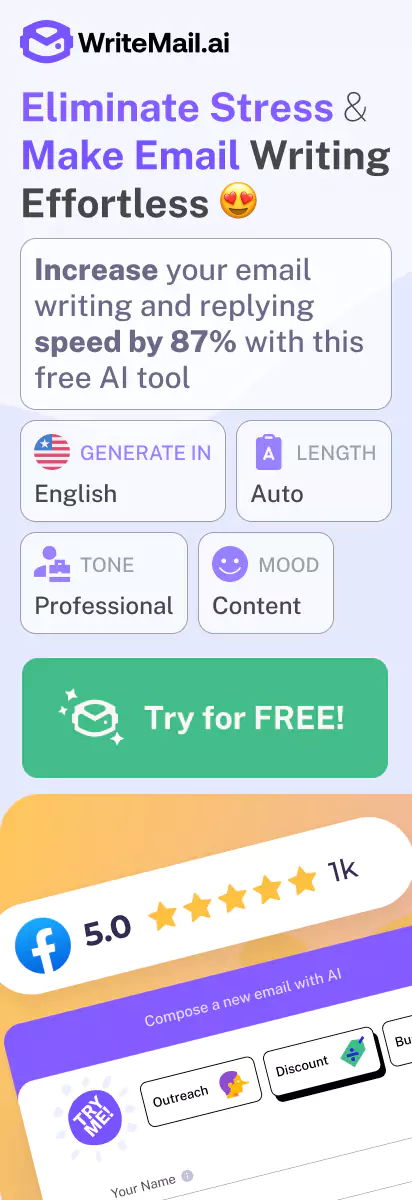Have you ever stared at a blank email, cursor blinking, wondering exactly how to ask your HR department for time off? You’re not alone. A surprising 54% of American workers report feeling uncomfortable or anxious when requesting leave from their employers, according to a 2023 workplace communication survey.
I’ve been on both sides of this equation, as an employee nervously crafting leave requests and as a manager reviewing them. Trust me when I say that how you structure your leave application email can significantly impact whether it’s approved smoothly or gets stuck in administrative limbo.
Writing to HR doesn’t have to be intimidating. When you understand the essential elements of a professional leave request and follow a proven formula, you’ll dramatically increase your chances of a quick approval. Plus, you’ll establish yourself as a thoughtful, organized employee who respects company processes.
In this guide, I’ll walk you through exactly how to compose an email to HR for a leave application that checks all the right boxes. You’ll learn the perfect subject line formulas that grab attention, the critical information you must include (and what to leave out), and see real-world templates you can adapt for any situation, whether you’re requesting vacation time, sick leave, or personal days.
By the time you finish reading, you’ll have the confidence to write clear, professional leave requests that respect your company’s policies while effectively communicating your needs. Let’s transform this potentially stressful task into a simple, straightforward process that works every time.
Essential Elements of an Effective HR Leave Application Email
When you’re preparing to request time off, crafting a comprehensive leave application email can make all the difference in how quickly HR processes your request. I’ve found that well-structured emails not only demonstrate professionalism but also make the HR team’s job easier. Let’s break down the essential components you should include in every leave request.
Subject Line Best Practices
Your email subject line serves as the first impression and helps HR categorize your request efficiently. I always recommend being specific and including dates right in the subject line. This simple practice helps your request stand out in a busy inbox and immediately communicates the nature of your email.
For example, instead of writing “Leave Request” or “Time Off,” try this format:
- Specific and complete: “Leave Application: Personal Leave, June 10-15, 2023”
- Include type and duration: “Sick Leave Request: April 3-7, 2023”
- Add employee ID if required: “Leave Application [EMP123]: Annual Leave, August 20-30, 2023”
Required Information to Include
When you write the body of your leave application, there are several critical pieces of information that HR needs to process your request efficiently:
- Leave type: Specify whether you’re requesting vacation leave, sick leave, personal leave, bereavement leave, etc.
- Duration: Clearly state the total number of days you’ll be away
- Start and end dates: Include the exact first and last days of your absence, specifying whether you’ll be working partial days
- Reason: Provide an appropriate explanation when necessary (detailed for sick leave, general for personal time)
- Contact information: Share how you can be reached during your absence if needed
I’ve found that organizing this information in a clear, scannable format makes it much easier for HR to process your request without having to search through paragraphs of text.
Example of a Properly Structured Leave Application Email:
Addressing Work Handover Plans
Research shows that 78% of HR managers appreciate proactive handover planning in leave requests. When you include information about how your work will be managed during your absence, you demonstrate responsibility and make it easier for your request to be approved.
Here’s what I recommend including in this section:
- Name of colleague(s): Identify who will cover your responsibilities
- Project status updates: Brief notes on ongoing projects and their status
- Handover timeline: When and how you’ll transfer knowledge before leaving
- Accessibility plan: How (if at all) you can be reached for truly urgent matters
This level of detail shows that you’ve thought through the impact of your absence and have taken steps to minimize disruption. I’ve found that managers are much more likely to approve leave requests when they see this kind of planning.
Following Company Protocol
Before sending your email, always check your company’s specific leave application procedures. Some organizations have:
- Required forms: Official documents that must be attached to your email
- Minimum notice periods: Required lead time for different types of leave
- Approval chains: Specific order of approvals (e.g., manager first, then HR)
- Documentation requirements: Medical certificates or other supporting documents
I recommend checking your employee handbook or intranet for these details before submitting any leave request. When you follow established protocols, you show respect for company processes and increase the likelihood of a smooth approval process.
Remember that your leave application email is an official document that becomes part of your employment record. Taking the time to craft it properly reflects your professionalism and helps ensure your time off is approved without unnecessary delays or complications.
Crafting the Perfect Subject Line and Greeting
When you’re sending a leave application to HR, the subject line is your first impression. It might seem like a small detail, but I can’t emphasize enough how crucial it is to get this right. A well-crafted subject line helps your request stand out in a busy HR inbox and ensures it gets the attention it deserves.
Creating Clear, Scannable Subject Lines
HR departments process dozens (sometimes hundreds) of emails daily. To make their job easier and get your leave request processed quickly, you need a subject line that’s immediately clear and scannable.
Effective Subject Line Formula:
- Start with “Leave Application” or “Leave Request” to immediately identify the email’s purpose
- Include the type of leave (Annual, Sick, Personal, Bereavement, etc.)
- Add the specific dates or duration
- Include your name or department if required by company policy
This structured approach helps HR immediately categorize your request and prioritize it appropriately. When you take the time to create a clear subject line, you’re demonstrating professionalism and respect for the recipient’s time.
Examples of Effective Subject Lines for Different Leave Scenarios:
Leave Application: Annual Leave, August 15-22, 2023 – Sarah Johnson
This subject line clearly indicates the type of leave (Annual), specific dates, and includes the employee’s name for easy reference.
Medical Leave Request: March 3-10, 2023 – Marketing Department
This format immediately identifies the nature of leave and includes the department, which can be helpful in larger organizations.
Urgent: Emergency Family Leave – February 17-20, 2023
The “Urgent” prefix signals that this requires immediate attention, while still maintaining all the essential information.
Choosing the Right Greeting
After crafting the perfect subject line, you need to consider how to address the HR department or representative. The appropriate greeting depends on your company culture and your relationship with HR.
Greeting Options Based on Formality:
- Formal: “Dear Mr./Ms. [Last Name]” or “Dear HR Department”
- Semi-formal: “Hello [First Name]” or “Good morning/afternoon HR Team”
- Casual (only if appropriate for your workplace): “Hi [First Name]”
When in doubt, I always recommend erring on the side of formality. You can always adjust your tone in future communications if you receive more casual responses. Remember that leave applications are official documents, so maintaining professionalism is important.
If you’re sending your leave application to a generic HR email address rather than to a specific person, “Dear HR Team” or “Hello HR Department” are safe options that work well in most contexts.
The Impact of Proper Formatting on Response Time
You might be surprised to learn that the way you format your email actually affects how quickly you’ll receive a response. Studies indicate that properly formatted emails receive responses up to 40% faster than poorly formatted ones. When your subject line and greeting are clear and professional, HR can quickly understand and process your request.
This efficiency benefit works both ways: HR spends less time deciphering unclear requests, and you get your leave approved more quickly. It’s a small investment of time that yields significant returns.
Consider this scenario: If you send an email with the subject line “Time off” versus “Leave Application: Annual Leave, June 10-15, 2023,” which do you think will be processed more efficiently? The second subject line gives HR all the information they need at a glance, while the first requires them to open the email and search for details.
Remember that most HR professionals view their emails in preview mode first, scanning subject lines to prioritize their workload. When you make your subject line detailed and descriptive, you’re helping ensure your request gets the prompt attention it deserves.
Now that you’ve crafted the perfect subject line and greeting, you’re ready to move on to the body of your leave application, where you’ll clearly state your request and provide all necessary details. But don’t underestimate the impact of these initial elements—they set the tone for your entire communication and significantly influence how your request will be received.
Writing the Body of Your Leave Application
When you’re crafting the main content of your leave application email, clarity and professionalism are your best allies. I’ve found that HR teams appreciate emails that get straight to the point while providing all necessary details. Let me guide you through creating the perfect body for your leave request.
Structuring your request: beginning with a clear statement of purpose
Always start with a direct statement of what you’re requesting. This immediately signals to HR the nature of your email and helps them categorize it appropriately. For instance, rather than beginning with “I wanted to let you know that I might not be around next week,” try something more precise like “I am writing to request annual leave from July 15-19, 2023.”
I recommend structuring your leave application body in this logical order:
- Purpose statement: Clearly state that you’re requesting leave
- Leave details: Specify the type of leave, exact dates, and duration
- Reason: Provide appropriate context (level of detail varies by leave type)
- Work continuity plan: Explain how your responsibilities will be handled
- Availability: Mention if and how you can be reached during your absence
Balancing detail and brevity when explaining your reason for leave
When explaining why you need time off, I’ve learned that different types of leave require different levels of detail. You’ll want to strike a balance between providing sufficient context without oversharing personal information.
For vacation or personal leave, a brief mention is usually sufficient: “I’m planning to use my annual leave to visit family” or “I’m requesting personal time to attend to some important matters.” For medical leave, you might say: “I need to undergo a medical procedure that requires recovery time” without elaborating on specific medical details unless required by company policy.
Remember, you’re generally not obligated to share highly personal details about your health or family circumstances. What’s important is providing enough context for HR to process your request appropriately.
Examples for different types of leave:
Using professional language while maintaining an appropriate tone
The tone of your leave application should be professional yet conversational. I always recommend avoiding overly casual language like “Hey there” or “I need some time off,” but also steering clear of excessively formal phrasing that feels stiff or impersonal.
When you’re writing to HR, aim for a respectful, straightforward tone that reflects your professionalism. Use complete sentences, proper grammar, and avoid slang or abbreviations. At the same time, you don’t need to sound like a legal document—a natural, clear writing style works best.
Words and phrases to use:
- “I am writing to request…”
- “I would like to apply for…”
- “I will ensure that all my responsibilities are covered…”
- “Thank you for considering my request”
Phrases to avoid:
- “I need some time off”
- “Just letting you know I won’t be around”
- “Hope that’s okay with you”
- “BTW, who should I hand my work to?”
Including relevant policy references or entitlements when applicable
If your company has specific leave policies or if you’re entitled to certain types of leave, mentioning these in your email can help HR process your request more efficiently. I’ve found this especially helpful when requesting parental leave, bereavement leave, or other specialized categories.
For example, you might write: “As per the company’s bereavement leave policy (Section 3.4 of the Employee Handbook), I am requesting five days of leave following the passing of my grandmother.”
Including these references shows that you’ve done your homework and understand your entitlements. However, be careful not to come across as demanding or entitled—frame it as information that helps facilitate the process rather than as leverage.
Remember that the body of your leave application email serves as an official record of your request. Taking the time to craft it properly demonstrates your professionalism and respect for organizational processes, while also ensuring your request is processed smoothly and efficiently.
According to a 2024 workplace communication study, HR managers spend an average of 37% less time processing leave requests when employees provide complete information in a well-structured format.
Addressing Work Continuity and Handover Plans
When you’re requesting leave, one of the most impressive things you can do is demonstrate that you’ve thought about how your work will continue while you’re away. In my experience working with HR teams, this single element often distinguishes thoughtful professionals from the rest. Let me show you how to create a handover plan that will make your leave request stand out.
Demonstrating Responsibility Through Detailed Handover Plans
Think about your leave request from HR’s perspective – they’re not just processing your time off, they’re concerned about operational continuity. When you proactively address how your responsibilities will be covered, you’re showing that you value the organization’s needs alongside your own.
Essential components of an effective handover plan:
- A comprehensive list of ongoing projects with their current status and upcoming deadlines
- Clear identification of which colleagues will handle specific tasks in your absence
- Information about where to find relevant documents or resources needed to complete your work
- Indication of any critical decisions or approvals that might be needed while you’re away
The level of detail you include will depend on your role and the duration of your leave. For a short vacation, you might need only a paragraph. For extended leave, you’ll want to be more thorough.
Naming Colleagues Who Will Cover Specific Responsibilities
Don’t just say “the team will handle things” – be specific about who will cover which responsibilities. Before including colleagues in your handover plan, I recommend having a conversation with them first. This courtesy ensures they’re prepared and prevents any surprises when HR or your manager follows up with them.
When naming colleagues in your email, be explicit about what you’ve already communicated to them:
“Sarah has agreed to manage the weekly client reports, and I’ve provided her with the templates and access to the necessary data sources.”
This approach reassures HR and your manager that the handover isn’t just planned – it’s already in motion.
Example of a detailed work handover section
Offering Flexibility Options Where Appropriate
While the purpose of leave is to disconnect from work, you might want to offer some flexibility depending on your circumstances. If you’re comfortable being contacted for truly urgent matters, say so – but be clear about the boundaries.
Consider these flexible accessibility options:
- Specifying certain times when you’ll check emails (e.g., “I’ll check emails once daily between 9-10 AM”)
- Providing an emergency contact number for truly critical situations
- Offering to join a specific pre-scheduled important meeting remotely
- Designating a hierarchy of contacts (e.g., “Please try Sarah first, then contact me if necessary”)
Be careful not to undermine your leave by being too available. If you’re taking time off for health or stress-related reasons, I strongly recommend setting firmer boundaries around availability.
Creating Comprehensive Handover Plans Efficiently
Creating a detailed handover plan doesn’t have to be time-consuming. Start by maintaining ongoing documentation of your key responsibilities – this makes handover planning much simpler when leave time approaches. You can use tools like WriteMail.ai to help structure your handover sections efficiently, ensuring you’ve covered all the essential details without spending hours drafting the perfect email.
Remember that your handover plan isn’t just about the email to HR – it’s about the actual transition of responsibilities. The more thoroughly you prepare your colleagues, the smoother your leave will be for everyone involved, and the more you’ll be able to relax knowing that operations are continuing smoothly in your absence.
According to a 2021 workplace efficiency study, employees who return from leave with well-executed handover plans report 42% lower stress levels during their first week back compared to those without proper handovers.
When you craft your leave application with a thoughtful continuity plan, you’re not just following protocol – you’re building a reputation as a considerate team player who thinks beyond their own immediate needs. This approach will serve you well throughout your career, making future leave requests more likely to be viewed favorably by both HR and management.
Closing Your Email Professionally
The way you close your leave application email can significantly impact how your request is received. A professional closing reinforces your credibility and shows respect for HR’s time and processes. Let me walk you through the essential elements of an effective email conclusion.
Crafting the Perfect Closing Statement
When you’re wrapping up your leave application email, you want to strike a balance between courtesy and professionalism. I recommend that you include a statement of appreciation for considering your request, followed by a clear indication of what you expect next.
For example, instead of abruptly ending with “Please approve my leave,” try something like: “I appreciate your consideration of this request and look forward to your approval.” This approach acknowledges that processing your request requires time and effort on HR’s part.
Strong closing statements you can adapt:
- “Thank you for reviewing my leave request. I appreciate your prompt consideration.”
- “I’m grateful for your attention to this matter and look forward to your response.”
- “Thank you for processing this request. Please let me know if you need any additional information.”
Requesting Confirmation Appropriately
When you need confirmation of your leave approval, how you ask for it matters. You should be direct but polite, setting clear expectations without sounding demanding.
If your company has a specific timeframe for leave approvals, you can reference it: “As per company policy, I understand leave approvals are typically processed within three business days. I would appreciate confirmation once my request has been approved.”
For time-sensitive requests, you might need to be more specific: “Since this leave begins next week, I would greatly appreciate confirmation by Thursday so I can make necessary arrangements.”
Remember, the goal is to request confirmation without pressuring the HR team. Frame it as helping you plan effectively rather than rushing their decision.
Professional confirmation request example:
Including Essential Contact Information
Research from the Society for Human Resource Management indicates that 92% of organizations require alternative contact details for employees on extended leave. When you provide this information proactively, you demonstrate thoughtfulness and responsibility.
If you’ll be completely unavailable during your leave, make that clear. However, if you’re willing to be contacted in emergencies, specify how and when:
Contact information to include:
- Your personal email address or phone number (if you’re willing to be contacted)
- Preferred contact hours or method (if applicable)
- Contact details for your designated colleague handling your responsibilities
- Expected response time if someone reaches out to you
For extended leave, you might want to set up an automatic email response with this information as well. I suggest adding a note about this in your leave application: “I will set up an out-of-office response with these contact details once my leave is approved.”
Adding a Professional Signature
Always end your leave application with a complete professional signature. This adds a final touch of professionalism and provides HR with your contact information for follow-up questions before your leave begins.
Your signature should include:
- Your full name
- Your position/title
- Department
- Work phone number
- Email address
For the sign-off itself, stick with professional closings like “Best regards,” “Sincerely,” or “Thank you.” Avoid overly casual closings like “Cheers” or “See you later” when communicating with HR about official matters.
Complete email closing example:
Remember that your closing is the last impression you’ll make in your leave application email. When you take the time to craft a thoughtful, professional conclusion, you demonstrate respect for HR processes and increase the likelihood of a smooth approval process. A well-structured closing also sets the stage appropriately for any follow-up communication that might be needed.
Follow-up and Special Circumstances
Even with the most carefully crafted leave application emails, you’ll occasionally face situations that require additional follow-up or special handling. Let’s explore how to navigate these scenarios while maintaining your professional image.
When Your Leave Request Goes Unanswered
It can be frustrating when you’ve sent a well-crafted leave application and received no response. I recommend waiting at least 2-3 business days before following up, as HR departments often handle numerous requests simultaneously. When you do follow up, keep your tone respectful and patient.
Follow-up Email Best Practices:
- Reference your original email (including date sent and subject line)
- Maintain a polite, understanding tone rather than expressing frustration
- Include any approaching deadlines that make the approval time-sensitive
- Keep it brief – HR professionals appreciate conciseness
Handling Emergency Leave Situations
Life doesn’t always give us the luxury of advance planning. When facing an emergency that requires immediate leave, you’ll need to modify your approach while still maintaining professionalism. Emergency situations might include family crises, sudden illness, or bereavement.
When you find yourself needing emergency leave, I suggest you:
- Call your supervisor or HR representative first, if possible
- Follow up immediately with an email that clearly indicates the urgency
- Be direct but respectful in your communication
- Provide essential details without oversharing personal information
Requesting Extended Leave or Special Circumstances
Extended leave requests, such as sabbaticals, parental leave, or medical leave, require more detailed planning and communication. When you’re preparing to request extended time away, I recommend starting the conversation well in advance.
Research from the Society for Human Resource Management shows that employees who request extended leave at least 30 days in advance (when possible) are 75% more likely to have their requests smoothly processed and approved.
Key Elements for Extended Leave Requests:
- Start with a face-to-face or video meeting before sending the formal email
- Include comprehensive handover documentation
- Reference specific company policies or legal entitlements
- Propose a communication plan for your absence
- Offer to assist with training temporary replacements
Using Technology to Handle Urgent Requests
When you’re facing time constraints or emotional stress during emergency situations, crafting an appropriate email can be particularly challenging. This is where tools like WriteMail.ai can be invaluable, helping you generate well-structured emergency leave requests or follow-up emails while maintaining the right tone and professionalism.
I’ve found that having email templates prepared in advance for various leave scenarios can save you significant stress when emergencies arise. Consider creating templates for:
- Medical emergency leave
- Bereavement leave
- Follow-up on pending requests
- Return-to-work notifications
Cultural Considerations for Leave Requests
When working in multicultural environments or international companies, it’s important to consider cultural differences in leave request etiquette. Some cultures value detailed explanations, while others prefer concise, direct communication. If you’re unsure about expectations in your organization, I recommend checking your employee handbook or asking colleagues who have successfully navigated the leave process before.
Remember that no matter the circumstances, maintaining professional communication with your HR department builds goodwill that can serve you well throughout your career. By mastering the art of leave request emails—from routine vacation requests to managing unexpected emergencies—you demonstrate your commitment to organizational processes even when you need to be away.
Perfecting Your Leave Application Process: Final Thoughts
Throughout this guide, I’ve walked you through the essential components of crafting effective leave application emails to HR. Remember that a well-structured leave request isn’t just about getting time off—it’s about demonstrating your professionalism and consideration for organizational processes.
When you take the time to write a proper leave application, you’re showing respect for your HR team’s time while ensuring your request gets processed efficiently. I’ve found that the most successful leave applications share these common elements:
- Clear, specific subject lines that immediately identify the purpose
- Professional greetings appropriate to your workplace culture
- Concise explanations with all relevant dates and details
- Thoughtful work handover plans that minimize disruption
- Professional closings that express appreciation
One final tip I’d like to share with you: always keep a copy of your leave application emails. This simple practice has saved me countless headaches by providing documentation if questions arise later about approved time off or work coverage arrangements.
If you find yourself frequently struggling with composing these types of professional communications, tools like WriteMail.ai can help you generate perfectly structured leave application emails in seconds, ensuring you never miss important details or strike the wrong tone.
I encourage you to implement these techniques the next time you need to request time off. You’ll likely notice not only faster responses from HR but also a greater appreciation for your professionalism. Each well-crafted email contributes to your reputation as a thoughtful team member who respects organizational processes.
Remember, effective communication is a skill worth developing, and your leave application emails are an excellent opportunity to showcase this ability. By following the guidelines we’ve discussed, you’re setting yourself up for success not just in getting your leave approved, but in all your workplace communications.
Here’s to taking well-deserved time off with the peace of mind that comes from knowing you’ve handled the process professionally!










